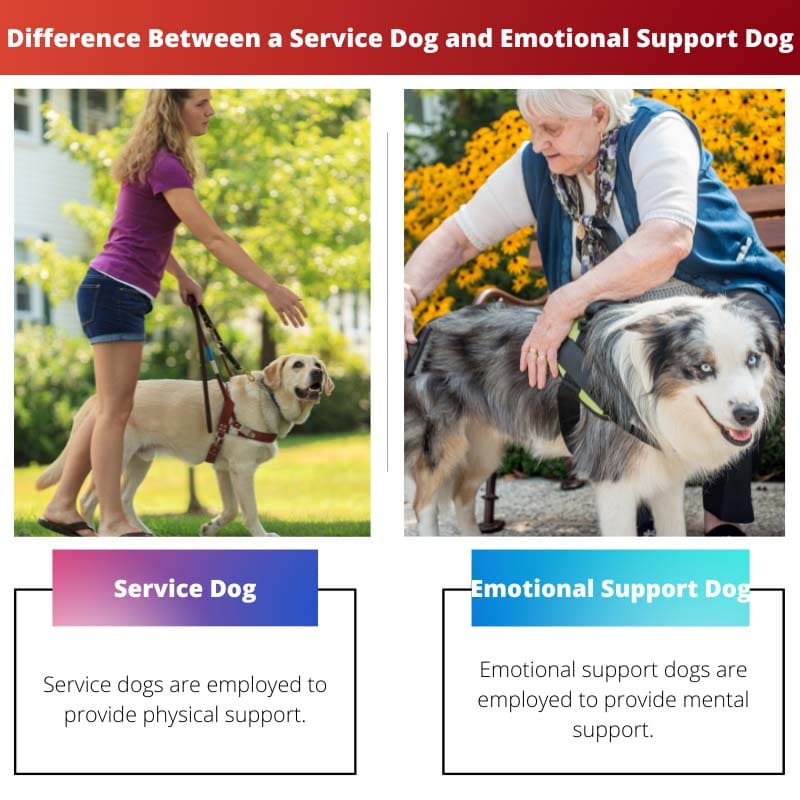Dogs are good companions. If a family has a pet-like dog, the dog is treated as a family member. They give great companionship.
People who live alone will search for love in pet animals. Dogs provide better security and passion for their owners.
Key Takeaways
- Service dogs undergo extensive training to assist people with disabilities, while emotional support dogs provide comfort and companionship to individuals with mental health issues.
- Legal protections differ; service dogs have access to public places under the Americans with Disabilities Act, while emotional support dogs don’t enjoy the same rights.
- Emotional support dogs don’t need specific training, whereas service dogs require specialized skills to perform tasks for their handlers.
Service Dog vs Emotional Support Dog
A service dog and an emotional support dog differ in their enactment towards their owners. The service dogs are well trained, whereas emotional support dogs are not trained as service dogs. Service dogs provide more excellent help to physically challenged people, whereas emotional support dogs provide therapeutic benefits to the owners.

Service dogs are well-trained dogs to execute various complex tasks that their owners can not perform. Usually, trained dogs are good companions for people with disabilities.
According to the American Disability Act, trained dogs must perform tasks and do specific work their owners order.
The primary functions of service dogs are to support while walking visually impaired people, to alert when vehicles cross, to help pick up objects and to support deaf people.
Emotional support dogs are different from service dogs. The emotional support dog’s primary function is to provide the owners therapeutic benefits.
Mentally unfit people are advised to take a companion from emotional support dogs. To afford an emotional support dog, the person must receive a medical diagnosis from a mental health professional.
They need a letter from the professional to get an emotional support dog.
Comparison Table
| Parameters of comparison | Service Dog | Emotional Support Dog |
|---|---|---|
| Work | Service dogs are employed to provide physical support | Owner Responsibilities |
| Training | Service dogs are trained to perform tasks | Emotional support dogs are trained to provide affection |
| Benefits | Service dogs are beneficial by doing work for the owner | Emotional support dogs provide therapeutic benefits |
| Passionate support dog owners must provide attention to the dog | Service dog owners need to take care of the dog | Service dogs are allowed by federal law to accompany on flights |
| Allowance | Emotional support dogs are not permitted by federal law to accompany in flights | Emotional support dogs are not permitted by federal law to attend on flights |
What is Service Dog?
Every country has its definitions for the services of service dogs. Service dogs can change the behaviour of people with disabilities.
They console them when people are in a difficult situation. They protect them from unwanted accidents.
Service dogs help physically challenged people to engage with the world and help them to grow. Service dogs provide more significant support to improve their feelings and make them work productively.
Service dogs easily attach to their owners. They show love and care towards their owners.
Before buying a service dog, you need to diagnose the disability and then buy the dog. The dogs are trained for disabilities separately.
They have separate training for each disability. The dog agency works with owners to find the perfect dog for the customers. Obtaining a service dog is easy, but you need to give proper attention to them.
By statistics, four breeds of dogs became successful as trained dogs after providing essential training.
Breeds like a Labrador, German shepherds, and golden retrievers are better service-providing breeds. Smaller dogs also provide excellent services by giving medical alerts.
The dogs need two to four months of training. They have high memory power. They can quickly learn things.
Most of the service dogs wear coloured vests to indicate the services. But this vest is not a requirement.
A dog provides service to people with disability wearing a blue vest.

What is an Emotional Support Dog?
People with mental and emotional challenges are advised to support of emotional support dogs. Disabilities like bipolar, depression, insomnia, post-traumatic stress, and anxiety can take help from emotional support dogs.
By statistics, forty disorders are classified that can be cured by emotional support dogs. Numerous agencies are available to register for free services and to buy a separate one. They are many designations for dogs based on the disorders.
Compared to the owners of service dogs, the owners of emotional support dogs can receive many federal protections. In recent years the love towards pet animals is increased.
They are not trained to perform tasks. Instead, they console the owners. People with psychological disorders may need support, and the emotional support dogs provide that support.
Dogs and any animals that provide emotional support are coms under emotional support animals.
The emotional support animals will provide their owner’s independence and help them improve their lives mentally. The emotional support dogs can attach to owners and show love towards them.
They are available whenever the owners need them.

Main Differences Between Service Dogs and Emotional Support Dogs
- Service dogs are employed to provide physical support, whereas emotional support dogs are employed to provide mental support.
- Service dogs are trained to perform tasks, and emotional support dogs are trained to provide affection.
- Service dogs are beneficial by working for the owner, but emotional support dogs provide therapeutic benefits.
- Service dog owners need to take care of the dog, whereas emotional support dogs must pay attention to the dog.
- Service dogs are allowed by federal law to accompany in flights, but emotional support dogs are not allowed by federal law to accompany in flights.




